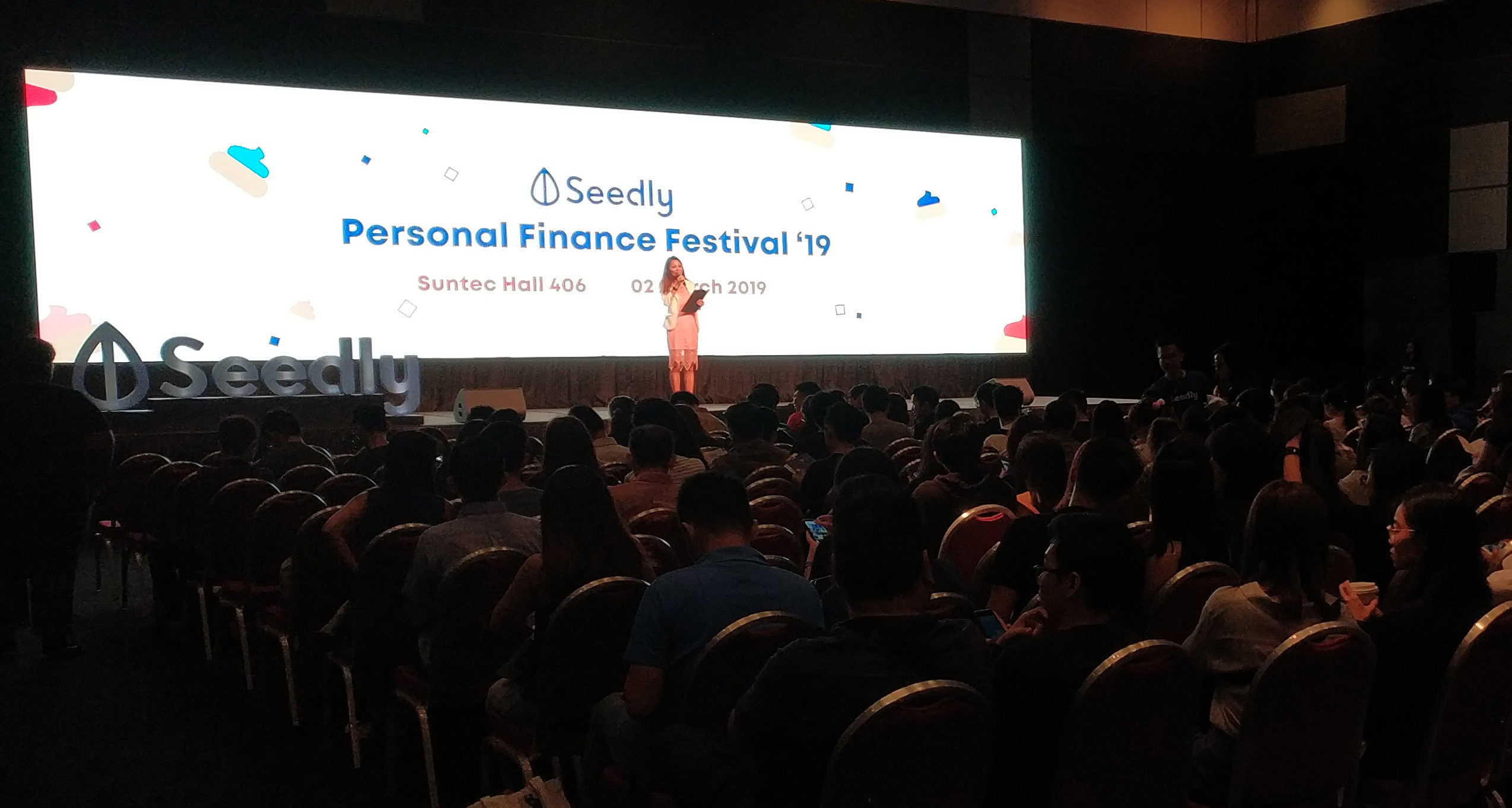My 6 key takeaways from the Seedly Personal Finance Festival 2019
Today, I spent 8 hours on a Saturday at Singapore’s largest personal finance event – Seedly Personal Finance Festival 2019. I repeat, 8 whole hours! That’s the number of hours I spend in the office on a work day.
Who would have thought that young adults would pay to wake up early on a Saturday morning to attend a 1-day event to listen about personal finance? Great job, Seedly!
I’m not going to do a full recap of what the speakers have said because that’s 8 hours worth of content and a blog article will not do the speakers justice.
What I’m going to do instead, is to highlight 6 key takeaways that resonated with me and I will take action on.
Please note that this article is my interpretation of what I heard from the speakers and may differ from the original meaning of the presentation.
Every week, I’ll be sharing practical tips and invaluable knowledge to guide you on your path to financial independence.
1. How long do you need to have insurance
When I planned my insurance needs, I looked at it from the perspective of how much do I need to recover from a critical illness or survive when I have problem taking care of myself. What I have not considered, is how long should I keep my insurance policies.
Christopher Tan, CEO of Providend and Executive Director of MoneyOwl shared his approach in deciding how long you need to have insurance. The income replacement component of an insurance plan is no longer relevant if you are of no economic value to anyone.
Let that sink in a bit.
If you are retired and no longer earn an income, you can consider not having some insurance policies such as Disability Income insurance and Critical Illness insurance that are meant events where you need to replace your loss of income.
Likewise, if you no longer have a dependent that needs to be supported by you, why should you continue to maintain a life insurance with a high death insurance coverage?
Action: I will examine my insurance plans and plan a cut-off age where I will reduce the coverage or even terminate some policies based on my retirement plans and dependent needs.
2. Job security may soon be a think of the past
In his presentation, Christopher Ng from Tree of Prosperity talked about how skillsets are deteriorating at a much faster pace. I totally agree with this comment.
In the past, if you were to study accountancy, you could work as an accountant for many years, or even decades using your accountancy skills. Today, if you graduate from university to become an accountant, your skillset will probably last 1-2 years (or less) before you need to learn new skills such as data analytics to perform high-level tasks as the industry continues to embrace automation.
Workplace toxicity is also present in many companies. Employees in Singapore are working much longer working hours than many other developed countries. The work life balance that we yearn for are not materialising.
Action: Identify skillsets that will improve my employability and take up courses to acquire these skillsets.
3. Build a financial safety net first before investing in the stock market
Loo Cheng Chuan from the 1M65 movement shared his story about achieving 1 million in CPF and talked about the benefits of acquiring a financial safety net through CPF before investing in the stock market.
I have to agree that knowing you have 1 million dollars waiting for you in your CPF accounts at 65 can provide you with a peace of mind. This peace of mind can be very powerful as you can afford to take more risk in your investment knowing your life isn’t over even if you incur some losses.
While I’m not planning to accumulate 1 million dollars in my CPF accounts, I intend to continue to pursue my mid term goal of achieving FRS in 5 years.
Action: Continue to top up my CPF Special Account to achieve Full Retirement Sum in 5 years’ time.
4. Grow your financial knowledge stack and don’t outsource your investment activities
Christopher Ng talked about the need to grow what he calls, your financial knowledge stack. Folks from the tech industry know the term, ‘stack’ very well. Essentially you equip yourself with knowledge on a set of technologies and programming knowledge that allows you to create and manage an application.
Likewise when we look at financial knowledge stack, it’s about equipping yourself with a set of financial knowledge to make informed financial decisions that’s tailored to your personal needs.
This is important because if we outsource the work of managing our personal finances and investment portfolio to what he calls, ‘financial salespeople’, these people are going influence you to act against your best interests if it conflicts with theirs (to earn commission).
Here’s the Financial Knowledge Stack that Christopher Ng shared.

Action: Put together my own Financial Knowledge Stack, identify what I lack in and work towards equipping myself with the relevant knowledge.
5. Choose an investment strategy, learn and take action
What I loved about the Seedly Personal Finance Festival was the diverse investment topics that the speakers presented. There’s no one-size-fits-all investment strategy that works for everyone. We have look within ourselves to identify the investment strategy that works for us. The one that allows us to sleep peacefully at night.
We had 3 speakers talk about 3 different investment strategies – Alvin Chow from Dr Wealth talked about Value Investing, Joel Sim from Mr Finance Savvy talked about Trend Trading and Victor Chng from The Fifth Person talked about Dividend Income Investing.
These speakers shared about their approach towards investment on a high level given the amount of time allocated for their sessions and provide some insights into why their investment strategies worked for them.
If you’ve been reading my blog, you’d find that I don’t write a lot about investing because that’s not a topic that I am well-versed on. I’ve only invested in index ETFs and done so through a Robo Advisor.
I had the opportunity to chat with Dawn Fiona from SG Budget Babe during the break and her recommendations for a newbie who is learning to invest for the first time. Here are some of her recommendations.
Before starting on your investment journey, ask yourself first these questions. What are you investing for? What’s your time frame in the market? And which methodology matches your personality and lifestyle better?
For some of us who are busy (e.g. parents) and don’t have time to check the markets regularly, strategies like fundamental momentum investing or trading will not be suitable for us because we cannot react in time and grab opportunities when they appear. In such cases, tools like ETF RSS plans or DCA methods would serve us better.
But if you enjoy analysing and have time and effort to spend on it, then why not value or growth investing which might be more suited to us.
Figure out which suits you better, learn more (through books or courses) and then apply and stick to it.
I intend to do something about that this year.
Action: Learn more about the 3 investment strategies shared in the festival and pick 1 that suits my preferences. Spend a lot of time to study on the chosen investment strategy.
6. Build your retirement portfolio, one brick at a time
Most of the festival attendees are young adults who are in the early stages of their careers. That means they don’t necessarily have a large sum of money to invest in their retirement portfolio today.
I love how Christopher Ng presented his lego-brick analogy to help young adults get started on building their retirement portfolio, one brick at a time. His example of ultimately forming a middle finger with 48 bricks that you can show to your unappreciative boss when you FIRE was the icing on the cake.
His take on starting your retirement portfolio was very simple. Save $20,000 and invest it on stocks, bonds, and REITS that yield better than 7%, and you will be able to get at least $1,400 a year.
That’s your first brick.
Action: Take a hard look at my retirement expenses and calculate the number of bricks I need to build in order to retire.
Did you attend the Seedly Personal Finance Festival? What were your takeaways from the festival? I’d love to hear about them in the comments section below.


For 6. Build your retirement portfolio, one brick at a time, are there other bricks that he talked about?
Hi SC,
Christopher Ng’s retirement portfolio is fairly simple and his retirement income is mostly derived from dividend yield. In his talk, his focus was getting the millennials to start saving $20,000, then invest in a dividend yield stock. If that works out for them, then just rinse and repeat the same process.
On the same point 6, I have also been reading up on other speakers and bloggers’ insights while the dividend yield is good for REIT (eg. More than 7%), we should not focus on yield alone but the sustainability of dividend distribution. It appears that most REITs issuing high dividend have been reporting a decline in yield y-o-y. What’s your take?
Hi SC,
This was why I enjoyed the Seedly Personal Finance Festival. They had 3 speakers to talk about different investment strategies – value investing, trend trading and dividend investing. I feel that it’s up to the individual to decide which strategy (or a combination) works better for him/her.
Victor Chng from The Fifth Person spoke about the criteria to selecting a dividend stock. On a high level, he emphasised that dividend payouts should be consistent over a number of years and they have to be sustainable (i.e. companies should not be paying out 100% of their earnings). Using his criteria, if dividends from REITs are on a decline, then those REITs should not be selected for your portfolio.
I must say I am not an expert in this area and I have so much more to learn on my investment journey.
I’ll try to put together an article on what I have learnt later this year. 🙂